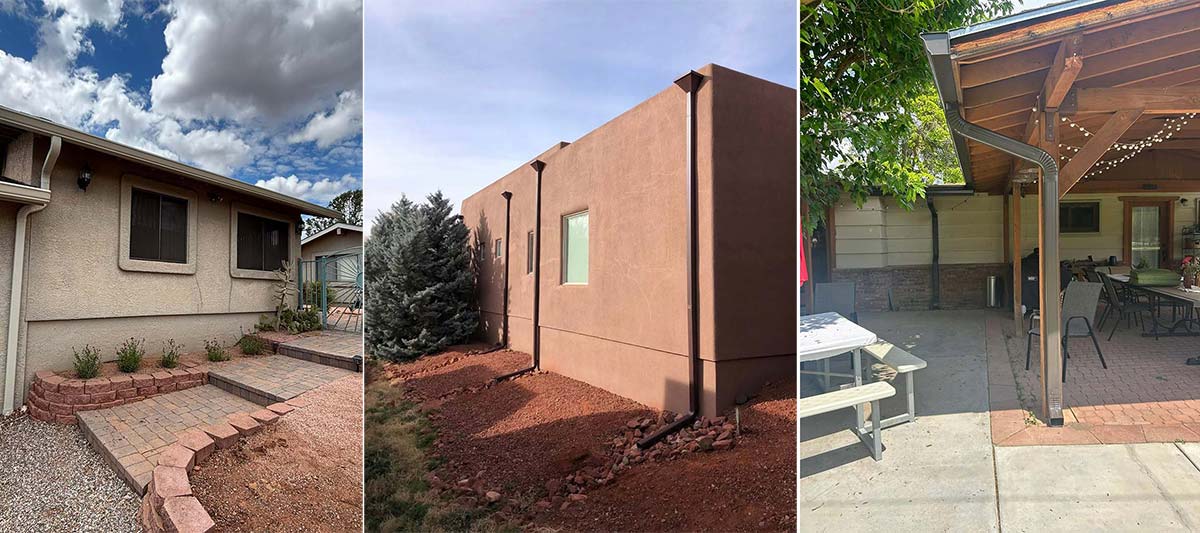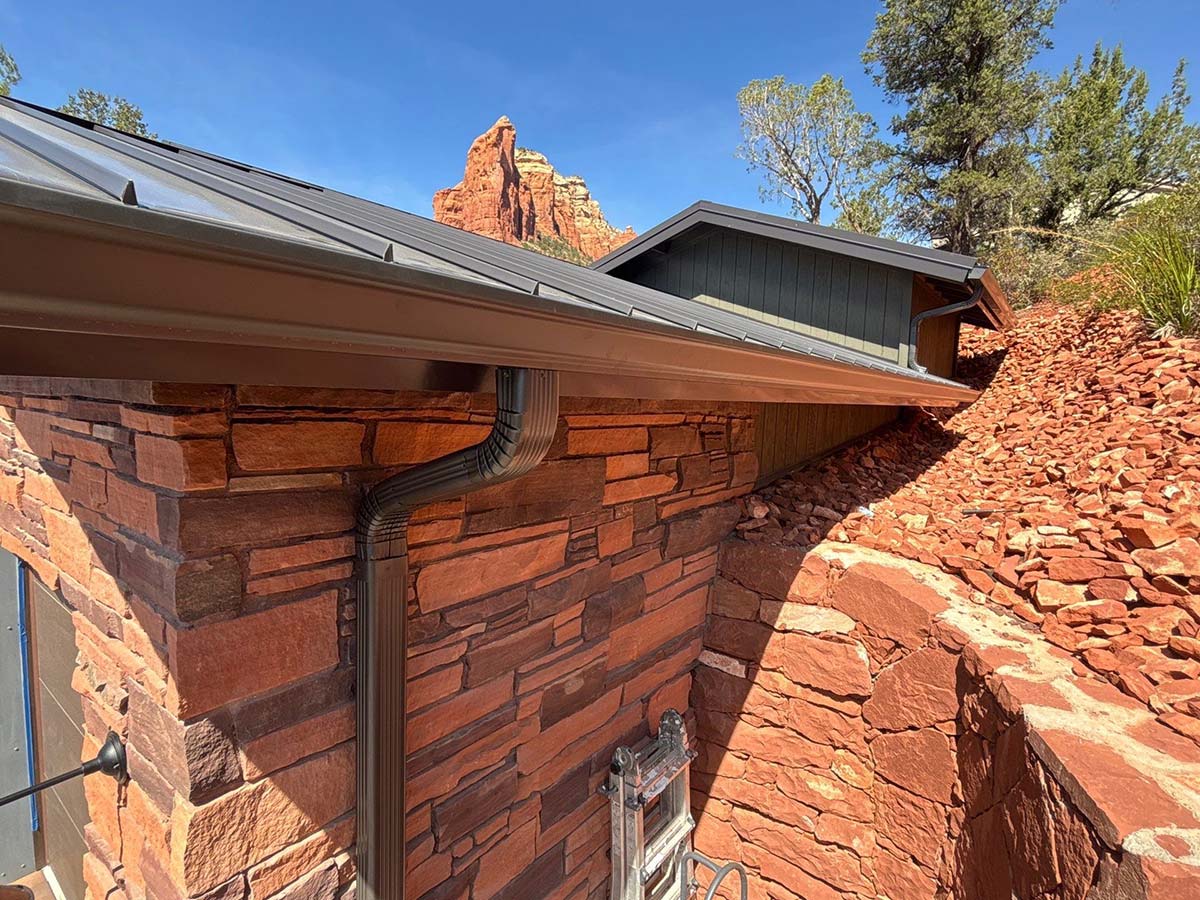You can have the nicest landscaping on the block—but if your gutters and downspouts aren’t doing their job, it won’t stay that way for long.
When water doesn’t drain right, it finds its own path. Sometimes that’s through your flower beds. Other times, it’s across your mulch, through your patio edging, or straight toward the foundation. A slow drip here and there might not seem like much, but over time? You’re looking at erosion, dead plants, or shifting soil where things used to feel solid.
In Sedona, the clay-heavy ground doesn’t give water anywhere to go. In Cottonwood, it might soak in deeper—but too much at once still causes trouble. Either way, poor drainage doesn’t just mess with your yard—it puts pressure on everything holding your home in place.
Signs Your Landscape Has a Gutter Drainage Problem
If your gutters are sending runoff in the wrong direction—or not far enough away—you’ll start seeing some of these signs:
-
Water pooling in low areas around your house
-
Soil erosion near flower beds or walkways
-
Washed-out mulch or bark after storms
-
Wet spots in your yard that stay soggy for days
-
Exposed roots or plants struggling near the foundation
-
Cracked patios or shifting concrete slabs
-
Standing water or stains near downspouts
Sometimes the damage shows up fast. Other times, it sneaks in slowly—settling the soil around your foundation, shifting landscaping, or causing rainwater to spill into crawl spaces or basements.
How Gutter Drainage Impacts Soil and Plant Health
Rainwater runoff is powerful stuff. When gutters are not sloped correctly or the drainage area isn’t prepared to handle flow, water will pool where your yard is weakest.
That constant runoff can:
-
Strip topsoil, especially on slopes
-
Expose or rot root systems
-
Cause compaction in heavy clay soils
-
Block proper absorption in low areas
-
Create ideal conditions for fungus or root rot
In Sedona, where landscaping is often built on rock or sloped beds, improper drainage can redirect water away from the foundation—but straight into a retaining wall, patio edge, or down a grade where it’s hard to control.
In Cottonwood, standing water near the foundation is more common. The soil soaks and holds water longer, leading to foundation damage or basement seepage if the system isn’t working.

Downspouts and Drainage Solutions That Actually Work
A basic downspout that ends two feet from the house isn’t enough—especially not during Arizona’s heavy rainfall months. Water needs to travel at least 4 to 6 feet away from your home to avoid damaging soil and structures.
Here are some effective solutions for redirecting gutter water:
1. Downspout Extensions
Flexible or rigid extensions that push water farther away from the house. Easy to add, great first fix.
2. Splash Blocks
Prevents soil erosion right under the spout. Works well on gutter systems with decent slope but shallow exits.
3. French Drains
A great option if water collects near your foundation or along hardscapes. Helps absorb water and move it away from the yard using buried pipe and gravel.
4. Dry Wells
Underground reservoirs that collect water from downspouts and let it soak slowly into the ground.
5. Rain Gardens
Landscaped zones planted in a low-lying area that can absorb water naturally. Good for water conservation, adds a pop of green.
6. Grading the Landscape
If water flows toward the foundation, re-grading may be necessary to direct it away. This works best when paired with proper gutter drainage and soil reinforcement.
What Causes Gutter Drainage Problems in the First Place?
There’s usually more than one thing going wrong when you see drainage issues in the yard. Here’s what we look for:
-
Clogged gutters from debris, twigs, or overflow
-
Poorly placed downspouts that end in flat zones
-
Short or disconnected drain pipes
-
Gutters that don’t slope or tilt properly
-
Landscaping that guides water back toward the house
-
Compacted soil or poor grading near the foundation
These all contribute to drainage problems that lead to runoff, erosion, and eventually, damage to your landscaping and home.
How to Keep Water Away from Your Home’s Foundation
You don’t need a complete redesign to solve most gutter drainage problems. Start by checking for these basics:
-
Are your gutters clean and free of debris buildup?
-
Do your downspouts drain properly and far enough from the house?
-
Is your yard graded to direct water away from the foundation?
-
Do you have areas where water will pool every time it rains?
Once you identify the weak points, you can build a plan. Sometimes it’s as easy as adding a longer elbow to your downspout. Other times, you’ll want a professional gutter company to assess the system from roofline to drainage zone.
And if you’re looking to install a french drain or rain garden, it’s best to hire a professional who understands soil type, drainage area, and stormwater flow.
Why This Matters in Arizona’s Climate
In places like Sedona and Cottonwood, we don’t get a lot of storms—but when it rains, it really rains. That means your gutter system needs to be dialed in. Otherwise, all that rainfall ends up near your foundation or washing out your hardscaping.
-
Clay soil makes drainage harder and increases the risk of pooling
-
Compacted soil limits absorption and causes water to bounce
-
Landscaping close to the house can accidentally trap runoff
-
Desert-style mulching can float away during overflow
The takeaway? Even low-maintenance landscapes need the right drainage solutions to stay that way.
Gutter Drainage Solutions Built for Your Yard
No two yards are the same—especially not in Northern Arizona. That’s why we take a custom approach to every gutter drainage solution we install.
We help redirect water away from homes using the right combination of:
-
Proper gutter slope
-
Downspout extensions
-
Landscape grading
-
French drains or dry wells
-
And when needed, full gutter installation or repairs
Whether you’re in the red rock hills or on flatter, greener ground, we’ll make sure your gutter system is ready for the next big storm—and your yard looks just as good afterward.
Dealing With Drainage Problems? Let’s Fix That.
Noticed soggy spots that never dry? Mulch always migrating after storms? Or maybe your yard just doesn’t look like it used to? That’s usually not just bad luck—it’s gutter drainage working against you.
Give us a shout. We’ll come out, walk the property with you, and figure out where the water’s going—and how to reroute it before it causes more damage.
Let’s keep your yard healthy, your foundation dry, and your home looking its best.


